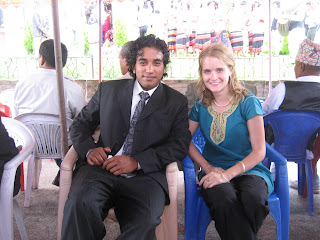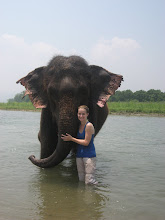Before this leads any of my family members into panic mode, I am going to take the focus off of me and discuss Nepali weddings.
My coworker Ram got married all this past week. He met Merina at ECCA several years ago and they’ve been dating for some time. She moved to Singapore for school hree years ago. When Ram found out that he’d been accepted into a Master’s program in Singapore last month, his parents and Merina’s met and officially agreed to an engagement. That happened on June 25. Less than three weeks later, the wedding process began. By July 22, they’ll be living in Singapore. It’s an incredibly quick process. Though some engagements last up to three or four months, many couples are married relatively quickly after becoming engaged.
I can in no way adequately describe the wedding process. I’ve participated in two weddings now, and still have so much to learn about all of the rituals and customs. Weddings here also differ considerably depending on which ethnic group you belong to and which caste level the bride and groom are within the ethnic group.
In the beginning, once the parents of the bride and groom have agreed to an engagement, the astrological signs and birth and lunar details of the bride and groom are compared to find the auspicious time for the wedding. This means that a couple could be married at 3 am on a Wednesday, or 11 pm on a Friday or any other time based on the lunar cycle and their birth details. (Often, a couple’s birth dates must be compatible prior to an engagement even taking place. If they are not, this is reason enough for them not to marry!). Luckily, in Ram and Merina’s case, the best time was on a Monday afternoon. The other wedding I attended took place at 2 am in the middle of the week (I didn't watch that part, clearly).
Then, the groom and his family initiate the marriage process by sending baskets upon baskets of sweets, fruits, fish, and other symbolic gifts to the home of the bride as an offering of marriage. The gifts of clothing and jewelry are kept by the bride if her family accepts the offer, and the food is sent back to the groom’s house to be displayed later by the bride’s family as a show of their wealth. The bride’s family will then host several receptions for her friends and family. The ceremonies here are almost always separate for the bride and groom’s family and friends.
I went to a wedding reception for the groom’s family and friends (though I think Merina’s family was there as well) on Sunday night, which was mainly just dancing and dinner for 400 to 500 people. This was an opportunity for his family and acquaintances to come by and congratulate the couple. Then on Monday, I went to Ram’s house with maybe 20 or so of Ram’s close friends and family. From Ram’s we traveled by bus to Merina’s house in the hills to “retrieve” the bride. Several ceremonies then took place at her home prior to her return to Ram’s house. Here are a few of the events that took place:
- The groom’s shoes are stolen by the bride’s family and his family must bargain for them by offering money and gifts
- The groom must be blessed by the oldest married woman in his family
- The bride must be fed specific food by her family elders and the priest, including egg, alcohol, and dried fish
- The bride must be carried to the marriage car by her uncle, who must circle the car three times clockwise prior to putting her in the car
- The bride and her family must cry in public to symbolize the pain of her leaving the family
- The priests (each family has one) must offer specific blessings to the couple for their marriage and health. These blessing ensure that the couple stays together through seven reincarnations.
The bride is then taken back to the groom’s house, where another ceremony is performed outside the house prior to her entrance into the family (in this case, it was definitely in the middle of the street). Then, the bride is kept mostly separate from the groom for the rest of the day while he celebrates with his friends and family. In Ram’s case, he visited Merina often (three of the other girls and I stayed with her most of the evening – painting our nails and eating snacks and chatting), but the only thing we did with the rest of his family and friends was to eat during the Newari (ethnic) reception.
Attending these weddings has been so interesting and a lot of fun. I love the traditions and rituals used in each part of the ceremonies, and it's fascinating to learn about the meaning behind many of the customs. My Nepali friends were all very surprised to hear how short and relatively simple American weddings are in comparison to Nepali ones. While we have many traditions, equally elaborate wedding receptions, and months of pre-wedding parties and showers - U.S. weddings still pale in in comparison to the ceremonies in Nepal. Nonetheless, I prefer the American freedom to choose your marriage partner and plan your own wedding (instead of having everything already planned for you). I also think maybe Nepali weddings are a bit too long (Monday's event was 12 hrs, for example) and expensive for my personal taste (I assume that my parents are sighing in relief at this point). But they are really beautiful.
I have beat the system today, and actually have been able to upload a few photos of the wedding! I have many other good ones that are on other cameras – I’ll either post them here later or put them on facebook.
Also, if I can manage it, my next post is going to be all the photos I’ve been trying to post since I went to Chitwan. We’ll see if I’m successful.
Love,
Lisa, who promises to stay unmarried for the next five weeks
At the reception on Sunday night with the happy couple - Ram and Merina. Anita is on the left and Suchita is on the right. My little Nepali sister, Palistha, is on the far right. I absolutely adore my sari, but was not, in any way, comfortable in it. It's really hard to walk, let alone dance, in. But it is by far the prettiest thing I've ever owned.










haha. yes he does! I remember thinking that once on some occasion that he had a tie on. they all do clean up rather nicely ;)
ReplyDeleteah good times!!